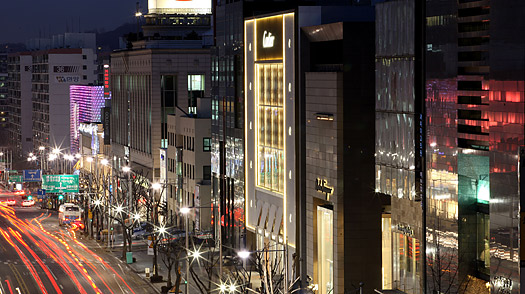
A view of luxury retailers on Apkujung-dong in Seoul, Korea, known locally as Rodeo Drive.
It's 19°F in downtown Seoul as Eugine Oh picks up her BMW 528 from valet parking at the Galleria Luxury Hall. Oh—wearing Antonio Marras and Milly, along with Manolo Blahnik Mary Janes and Ray-Ban aviators—explains that when something arrives at Maison Martin Margiela, one of the boutiques at the upscale Cheongdam-dong department store, she can always expect a text message from the store manager. "It's helpful because if you're busy, you might not be paying attention, and you don't want to be behind," she says.
A trend researcher for South Korea's leading entertainment and media company, Oh, 28, likes the under-the-radar Maison Martin Margiela (named for the reclusive Belgian designer) because it has a story. "What's the point of having what others have? The Louis Vuitton Speedy bag was nicknamed the '3-second bag' because you can see it every 3 seconds," she says with a laugh, admitting that she, too, used to buy Louis Vuitton bags to show off. With a father who is an importer-exporter in the garment industry, which made her privy to foreign brands at least two years before they came to Korea, and having attended high school and college in the U.S., Oh used to feel light-years ahead of Seoul fashion and its followers. "Not anymore. You can buy anything here," she says. "Seoul is so wired. And girls in Korea are quick. They study the trends and sources of information available to them." (Read about the most innovative women in the global fashion industry.)
Korea has come a long way since the 1970s, when ruler-bearing policemen stopped women on the street to measure the length of their skirts. Outside the Galleria, Cheongdam's main drag is lined in luxury as block after block exalts the flagship and stand-alone stores of the titans of fashion: Gucci, Louis Vuitton, Hugo Boss, Dolce & Gabbana and Jil Sander. A few "Coming Soon" signs for brands such as TSE and MCM wrap around construction sites like monogrammed presents waiting to be opened by eager shoppers. This is Seoul's Champs-Elysées, a concrete-and-glass table of contents for the global fashion brands that also fill Seoul's department stores, such as Lotte, Hyundai and Shinsegae, Korea's oldest. Retail rents in the Cheong-dam and Apkujeong neighborhoods—the priciest in Korea—have quadrupled over the past 10 years. As on Rodeo Drive or Fifth Avenue, if a store hasn't arrived here, it hasn't arrived in the eyes of the brand-conscious Korean consumer.
Just 12 years after opening as a liberalized market, Korea—Asia's fourth largest economy—is now a boomtown for international brands taking advantage of double-digit growth in the luxury sector, even amid Korea's severe economic downturn. This winter, Prada Asia Pacific launched Miu Miu here. And this month, Prada begins the Transformer project at Seoul's Gyeonghui Palace. Designed by architect Rem Koolhaas, the tetrahedron-shaped building will physically transform throughout the summer, rotating in cadence with different monthly cultural programs related to art, film and fashion. Sebastian Suhl, CEO of Prada Asia Pacific, says the launch is a testament to the importance of the Korean market. "Asia over the last years has shown explosive growth," he says. "Korea has high double-digit growth and the market is extremely resilient."
And resilience is looking pretty good to the luxury goods sector about now, as the region's economies suffer in the global decline. Korea's estimated economic growth for 2009 could fall below 2%, compared with last year's 5%. Central Seoul and its luxury brands, however, seem unfazed. While the pace of some businesses might be slowing to that of treacle on a winter's day, foreign fashion brands have been seeing growth between 20% and 30%. And the plummeting won is making Korea very attractive to Japanese consumers. At Van Cleef & Arpels in the Galleria Luxury Hall, 80% of the sales this past October and November were made by Japanese shoppers—a 228% increase in purchases by Japanese consumers over the previous year. Associates at Louis Vuitton in Apkujeong say that while sales have been steady, locals aren't the ones buying. Meanwhile, according to South Korea's National Statistics office, Internet sales of luxury fashion brands in Korea hit a record high of $15.7 billion last year, up 18% from the previous year.
But Seoul isn't Tokyo or Hong Kong. And as the Korean luxury market rapidly matures, women like Oh want more from their brands. Gene Krell, fashion director for Vogue Nippon, says when he first went to Seoul 14 years ago, the influence of foreign fashion was nil. "The notion of the fashion business was so abstract, they wouldn't have known Balzac from Balenciaga," he quips.
Krell, who subsequently launched seven Condé Nast magazines there (including Vogue Korea), says modern Seoul has come a long way since the days when he couldn't buy a bottle of olive oil. But as the city has changed and consumers have become more sophisticated, their fundamental desire for quality craftsmanship—and women's preoccupation with beauty, perfection and glamour—appears to feed growth in the fashion market. "Korean people have tremendous respect [for] and loyalty to their brands. It's an amazing tenacity. Fashion is a vessel and a visual outcome of all of that," says Krell, who notes that Korean consumers know how to integrate clothes. "It's not a case of how clothes should be worn, but how clothes can be worn."